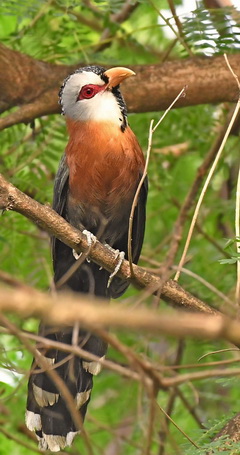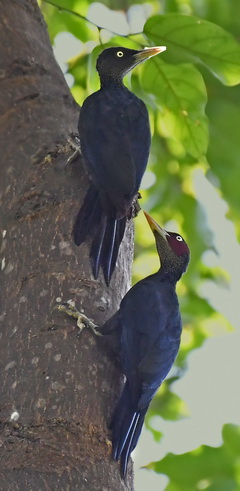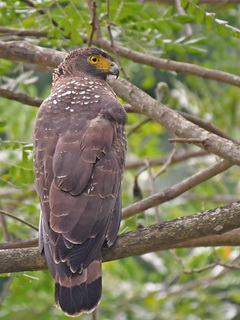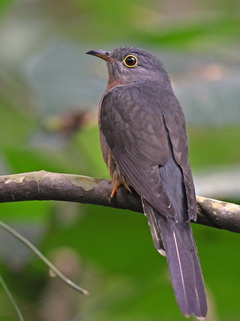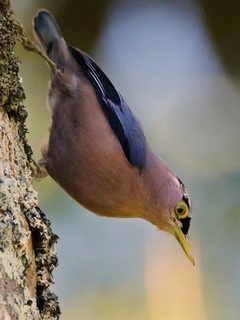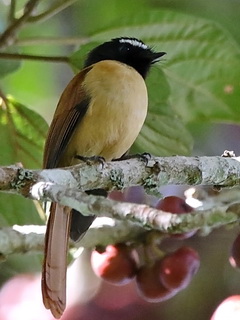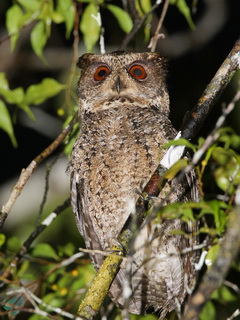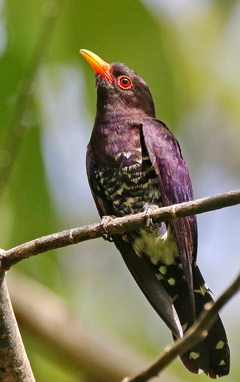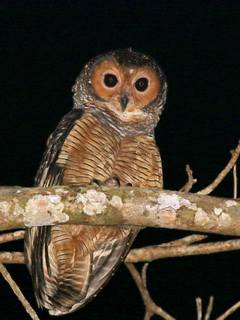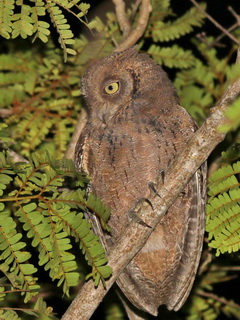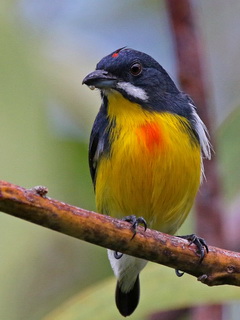B2A Philippines birding
tour report.
Luzon, Mindanao, Palawan, 28 Jan - 12 Feb 2019
Participants; Paul and Sheila Ashley
(UK), Stephen Harford and Jean Mckell (UK),
Sjaak Tijm (Netherlands), Ann Esmas (USA)
Tour leaders; Stijn De Win & Pete
Simpson
Candaba, Subic, La Mesa, Angono, Makiling,
Mt. Kitanglad, Davao, Picop
Sabang-Underground River, Iwahig, Irawan Eco Park
Our relatively short Philippine tour focusing on the best birding sites and maximum endemics within the available time remains a very popular concept and always attracts an interesting mix of birders. This year was no else, we had couples from the UK and singles from Netherlands and the USA in a keen but easy going small group.
This tour runs at a good pace and we met bright and early in the hotel in Manila. All needed was a quick breakfast and beat the traffic to La Mesa Park to start the birding. Philippine (Pygmy) Woodpecker was our first endemic. Pygmy Flowerpecker showed briefly and we left a Philippine Serpent Eagle sit in plain view as we went for the bird La Mesa Park is all about. As usual Ashy Thrush takes some finding and we walked the same loop twice before we got excellent looks and photos of this overly handsome Thrush species. Close views of a female Black-chinned Fruit-Dove were well enjoyed before the Ashy Thrush put in another appearance, this time with a nice background image for the photographers as it sat up low and close on a branch next to the path. On our way out of the park a Black-naped Oriole sat unusual low providing further photo opportunities. Last Ann found for us an incredibly close Rusty-breasted Cuckoo that just didn’t want to fly off. What an excellent find.
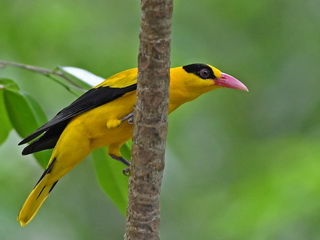
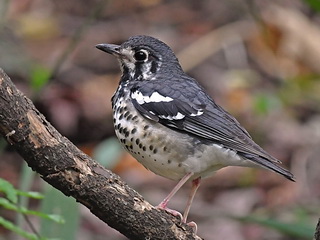
Water levels at Candaba Marsh were such low this year that we actually managed to not see a single (Philippine) Duck! While truly worrisome for the birds and birding on site it isn’t a disaster for the tour as there are a couple other possibilities to catch up on the Philippine Duck later on. (Or in Taiwan as I did once haha.) Candaba remains interesting and even in the hot midday sun we managed good views of Barred Rail, Buff-banded Rail, Yellow Bittern, White-browed Crake, Lesser Coucal, Arctic (Japanese) Warbler and Eastern Yellow Wagtail. A Middendorf’s Grasshopper Warbler got into a bit of song from dense reeds but remained hidden together with a Siberian Rubythroat giving soft calls. Numbers in the colonies of Purple Heron and Black-crowned Night-heron seem to increase in the tall grass and reeds now taking hold of the pond due to the lack of much water. Also Oriental Skylark seems to be a new arrival in the ever increasing area of dry fields. So it’s not only ducks but also “people’s rice” which is on the decline here due to a lack of water.
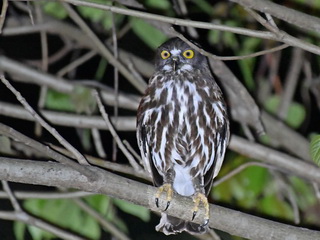
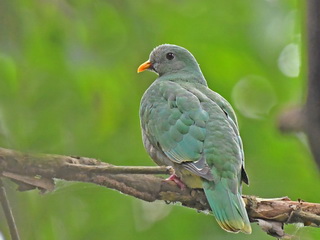
Subic was as excellent and pleasant as ever and we enjoyed our first full day watching many of the specialities of the area; Green Racquet-tail and Blue-naped Parrot, Colasisi and Guaiabero, Sooty Woodpecker, Luzon Flameback, White-bellied Woodpecker, Luzon Hornbill, Rufous-bellied Hawk-Eagle, Philippine Falconet, Whiskered Treeswift, Strip-headed Rabdornis, Brown-breasted Kingfisher, Rufous-crowned Bee-eater, Blackish Cuckooshrike, Balicassiao and Elegant Tit all showed very well. After lunch we stopped at the Fruit Bat colonies and managed good close looks of Lowland White-eyes on a stake-out while a lone Black-winged Stilt sat in a surprise location on boulders at the seaside. Later in the afternoon we put in further effort to improve sightings of Red-crested Malkoha and Rufous Coucals which eventually did work. White-browed Shama put in a brief appearance while its song was certainly admired and we also heard Plain Bush Hen. At dusk Great-eared Nightjars put on a show and superb views + photos of Chocolate Boobook meant we were ready for dinner and a beer.
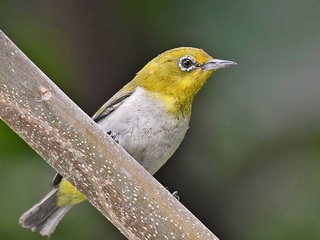
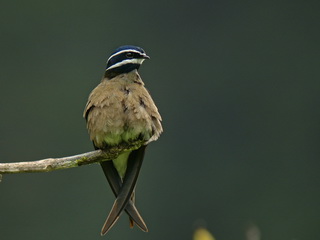
With our perfect introduction of Philippine forest birding well enjoyed at Subic it was time for some good work at Mount Makiling and while the birding here may be slow at times we did add a few goodies. An early start and a good job on views of Philippine Hawk Owl got us ready for the forest walk. A Philippine Trogon has been in the same spot for years along the forest track but it just didn’t want to come in close enough this time. More important though, we got an excellent performance of a Spotted Wood Kingfisher. We had heard them already at Subic. Makiling was our last chance seeing it on the tour so we did well on this. Same for Grey-backed Tailorbird, an extreme skulker missed at La Mesa previous but now putting on a nice appearance with good looks for all. Rufous Paradise Flycatcher was on stake-out and on schedule again this year. What a beauty this is and it was joined by a couple Yellow-bellied Whistlers. Scale-feathered Malkoha was heard a couple times but we didn’t do much effort locating those as we had a superb pair of those at Angono the previous day. I believe these guys belong in the top 3 of best looking birds on Luzon. While seen on every tour so far they aren’t usually lingering long and this was only my second opportunity ever for good photographs. From the old days, my first Scale-feathered Malkoha photo appeared in the Helm field guide “Cuckoos of the world”. Not sure the new photos are better but very happy to get such a good performance of these superb birds for the whole group on this tour.
In the afternoon we were after Indigo-banded Kingfisher carefully checking the river at the botanical garden but no show. Also on the campus bridge no sign of the Kingfisher so we watched Striped Flowerpecker, Coppersmith Barbet, Striated Swallow and House Swifts with a flock of about 15 Eye-browed Thrush going overhead. In the open fields near the campus a pair of Painted Snipe posed well and we enjoyed White-browed Crake, Buff-banded Rails and Oriental Skylark again. Introduced Crested Myna and Java Sparrow seem to be increasing in numbers here while both species are getting difficult and scarce in their home ranges. This marked the end of birding on Luzon so it was off for a little time in the hotel’s pool before dinner with an early transfer scheduled to Manila airport for our flight to Mindanao the next morning.
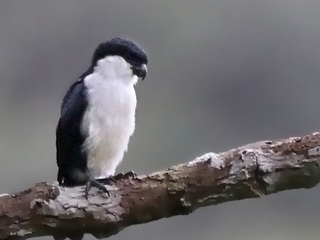
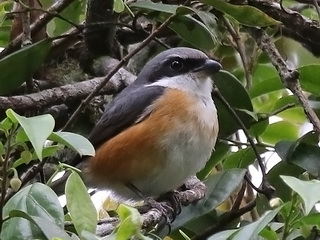
The group met with Pete upon arrival at Cagayan de Oro airport and headed south to Bukidnon for an afternoon walk up Mt Kitanglad. After a very wet January we walked up in what turned out to be the start of a prolonged dry spell. The weather makes a big difference to the birding on Mt Kitanglad. Timing of a visit is important with Dec-Jan usually too early (wet) in the year. The trail up is of moderate difficulty, 4km rising from 1000masl to 1350masl, mainly through farmland but with a steep section through a forested valley. At a birding pace it is manageable in a couple of hours in the dry and is enjoyable but in the wet it is rather slippery. At the end of the walk we reached the Del Monte Lodge, a grand sounding accommodation but basic in reality. A peaceful setting in the middle of the forest makes up for the lack of electricity but there are comfortable foam beds and blankets, a dormitory and tents, and a kitchen that provides great food. As honoured guests there was even beer in the ice box that stayed cold for the duration of our stay.
We had arrived early enough to settle into our accommodation before some evening birding, starting at an open area 100m up from the lodge. Philippine Nightjar were the first to call just after sunset, then display over the low bracken in front of us. Bukidnon Woodcock was seen soon after, the prize night bird here and the site at which it was first described just thirty years ago. We were then further spoiled on our first night when local guide Carlito called in his friendly Philippine Frogmouth for excellent views.
On day two we ate breakfast in the dark, listened to Great-eared Nightjar calling around the lodge and started to walk up as it got light. A similar walk to the previous day, this time from 1350-1500 masl, but with many more birds to take in on the way. After a short steep section we passed fruiting trees that held Yellow-breasted fruit Dove and White-eared Brown Dove. Crested Goshawk perched in fantastic early morning light while Sulphur-billed Nuthatch entertained us with its upside down feeding behavior. We added Short-tailed Starling before we arrived at the Philippine Eagle watch point, an open area with a great view up to the forested peaks of the Mt Kitanglad range.
Between scanning for Philippine Eagle we worked our way through other available montane birds; Mindanao Racquet-tail flew over squawking, McGregor's Cuckooshrike were picked up on their odd call and responded well to tape. Olive-capped Flowerpecker and Grey-hooded Sunbird were in the area and a small flock of the unique looking Apo Myna passed through. A stunning male Fire-breasted Flowerpecker displayed in front of us for ten minutes, but then in the late morning the bird activity dropped and it started to get quiet. That is until Philippine Eagle flew in to view, and then there was a lot of shouting, a rush to the scope, a little dancing, a few high-fives. Top of the wanted list for almost every birdwatcher visiting the Philippines, largest and rarest eagle in the world, Mt Kitanglad had again provided for us. It wasn't close, it didn't fly over our heads, but no one complained. This is a massive bird, more than 2m wingspan, visible at a distance to the naked eye, great through bins and through the scope we could see plenty of detail.
Lunch arrived soon after, fresh cooked and carried up quickly by horse. We rested and then continued to work our way through the list, in the watch point area and during the slow walk down. We added Stripe-breasted Rhabdornis, Buff-spotted Flameback, migrant Mugimaki Flycatcher, the odd looking Cinnamon Ibon, the poorly named Negros Leaf Warbler and the striking Black-and-cinnamon Fantail. We stopped for some skulkers and managed to coax out White-browed Shortwing and Long-tailed Bush Warbler. We were back at the lodge in the late afternoon for a coffee, hot bucket shower and relax time before a frustrating owling session where Giant Scops Owl, Everett's Scops Owl and unusually Mindanao Scops Owl were all heard, but not seen.
Seeing Philippine Eagle on the first day allowed us to walk higher on the second day, past the watch point in to the covered forest, all the way up to 1800masl. When we reached the eagle watchpoint we were greeted by a squadron of Purple Needletail overhead. In the forest we added Yellow-bellied Whistler and Rufous-headed tailorbird. The long walk up has one main target, the high altitude Apo Sunbird. We reached the right altitude, found the flowers and just had to wait for the hyperactive bird to reach this point on its feeding circuit. The bird arrived, flitted between the bright red flowers and departed. I thought we were done but then we had a bonus as a Mountain Shrike appeared from nowhere, a species usually at even higher altitude and seldom seen here.
Our last morning at Del Monte was mainly about breakfast, breaking camp and preparing for the walk down, but we still managed to add species. Blue-capped Wood Kingfisher was calling pre-dawn and responded at first light, flying over us to call from a new position. On the walk down some of us were lucky enough to get on to Red-eared Parrotfinch feeding in the low grass next to the trail.
Another Mt Kitanglad/Del Monte Lodge tour was over and it was a pleasure to share it with a group who all thoroughly enjoyed it, who could see past the hard walks and basic accommodation to enjoy the birds, the isolation, tranquility and the unique experience.
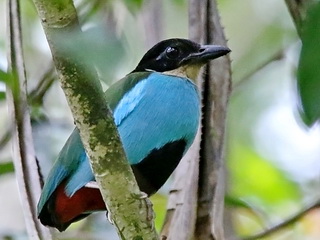
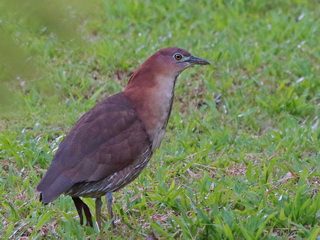
We headed by road to Davao City, arriving at our comfortable resort on Mt Talomo in the mid-afternoon. Time for a hot shower before a short walk to our first target, Cryptic Flycatcher. The bird was present and vocal, but for today remained heard only and not seen. A short drive away and we were on to one of the birds that has recently put Davao on the global birding map, we scored not one but two wintering Japanese Night Heron, and we didn't just get to see them, we got to watch them, to observe them stalking and feeding.
The following morning we were higher up the mountain watching a pair of territorial Whiskered Flowerpecker before 6am, back inside the resort with Southern Silvery Kingfisher and those elusive Cryptic Flycatcher seen, all before breakfast. We left Davao and headed East, Bislig was our final destination but we stopped at a coastal site on the Gulf of Davao. We were searching for Davao's newest draw, a small wintering population of the critically endangered Chinese Crested Tern. They were not in evidence today but we would connect later on our second chance after our time in PICOP, and for today we enjoyed the spectacle of one thousand Whiskered Terns and an impressive spread of waders that included Pied Stilt, Far Eastern Curlew, Red-necked Stint and Grey-tailed Tattler, and a lone Chinese Egret.
Rain that afternoon meant we postponed our session at Bislig Airfield . We had an early night in preparation for the first of a run of early visits to the little remaining lowland forest of the former logging concession that is PICOP.
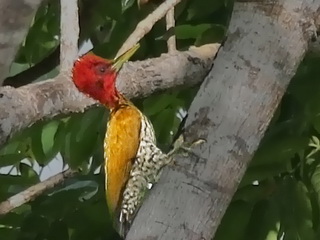
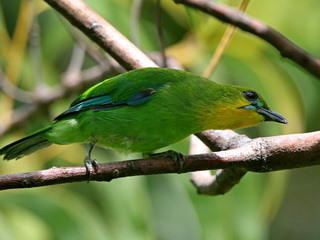
After a very early departure and a bumpy jeepney ride we started owling in the forest at 4h30am, and what a productive session it was, with Everett's Scops Owl and Mindanao Hawk Owl both seen. From sunrise we were inundated with new birds, Philippine Green Pigeon, Black-faced Coucal, Philippine Drongo-Cuckoo, Black-and-white Triller and Philippine Leafbird. All three Bulbuls were present as we took breakfast; Yellow-wattled Bulbul , Yellowish Bulbul and Philippine Bulbul. A short walk and we had added Orange-tufted Spiderhunter and Naked-faced Spiderhunter. We noted that here in the forest the usual Ridgetop Swiftlets (Glossy Swiftlet) were replaced by Pygmy Swiftlet and high above us were Ameline Swiftlet. On our first day we managed all three available hornbills, that is Mindanao Hornbill, the largest, Rufous Hornbill and the rarest here on Mindanao, Writhed Hornbill. Later we added Philippine Falconet, Scarlet Minivet and watched as Handsome Sunbird constructed a nest. Mixed flocks were thin on the ground but we managed to see a lone responsive Rufous Paradise Flycatcher.
In that first day at PICOP we managed 60 species in the forest, of which more than half are Philippine endemics, and that was all before 1pm. We headed to the dirty pond stakeout for Southern Silvery Kingfisher. It took a while to pin down but in the end we all got good scope views of this tiny red-footed gem. That was followed by a late afternoon session at Bislig Airfield which gave us White-bellied Sea Eagle and great views of Eastern Grass Owl.
Our second day in PICOP was at a further site, again we managed 60 species, but many were different from the previous day. Amethyst Brown Dove, Philippine Spine-tailed Swift, Pinsker's Hawk-Eagle calling overhead and Rufous-lored Kingfisher unusually responsive. We were all happy with our views of a territorial Azure-breasted Pitta and we finally got some mixed flock action. We added Mindanao Blue Fantail, Philippine Leaf Warbler, Rufous-fronted Tailorbird, Rusty-crowned Babbler, Mindanao Pygmy Babbler and finally one of the key birds for the site, Short-crested Monarch. Striated Wren-Babbler made us work for good views but a stunning male Violet Cuckoo came and perched almost too close to focus.
We still had birds to see on our last morning, but started with repeat views of Short-crested Monarch. We persevered to make sure everyone had an acceptable look at the skulking Black-headed Tailorbird and then added White-bellied woodpecker and Olive-backed Flowerpecker. After lunch we were headed back to Davao City and stopped at the coast. This time managed to locate the Chinese Crested Tern, not just one but two birds present, that is 4% of the estimated world population.
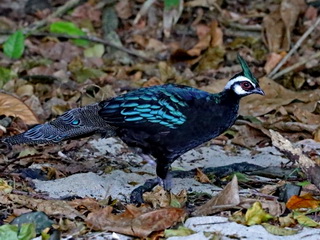
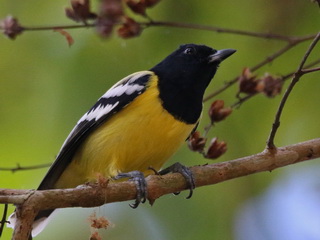
After a night in Davao we departed Mindanao, arriving to Palawan in the afternoon, a travel day but still with opportunity to add a great bird in the evening. From Puerto Princesa it was a short drive and boat ride to a small island, for a small island specialist. As the sun set we heard the strange grunts of Mantanani Scops Owl and soon had the bird in the spotlight. The following morning found us watching Palawan Frogmouth within walking distance of the hotel. After an early breakfast and drive we enjoyed a morning of comfortable forest birding from the roadside. We made an impressive start with Black-chinned Fruit Dove, White-vented Shama and one of the tough ones, Red-headed Flameback. We soon completed the bulbuls; Black-headed Bulbul, Ashy-fronted Bulbul, Palawan Bulbul and Sulphur-bellied Bulbul. Keen birding continued when we managed Palawan Flowerpecker, Pygmy Flowerpecker, Lovely Sunbird and Pale Spiderhunter in a single tree. A roadside stop on the way back to Puerto Princesa gave us Copper-throated Sunbird in the mangroves. Palawan is definitely more birdy than the other islands, even looking through the restaurant window during lunch we managed Yellow-throated Leafbird, Pygmy Flowerpecker and Brown-throated Sunbird. Heading to Sabang in the afternoon we stopped for Changeable Hawk-Eagle and Slender-billed Crow.
Late in the afternoon we had a great session from the lookout. A family of Palawan Hornbill flew across the forest opposite, Great Slaty Woodpecker performed well. We had numerous fly-bys from noisy Blue-headed Racket-tail and Blue-naped Parrot . And finally the reason for visiting this site, a sizeable group of the critically endangered Red-vented Cockatoo flew past us to their roost site. And still our stunning first full day on Palawan was not finished. We had time to clinch Palawan Scops Owl and a fantastic Spotted Wood Owl before dinner.
The following morning we boarded boats early to be the first visitors at the ranger station of the Puerto Princesa Subterranean River National Park. The first dark shape we saw moving through the undergrowth was Philippine Megapode, smaller and moving faster we got on to Ashy-headed Babbler. Finally the Palawan Peacock-Pheasant came out to display for us, as it has done for grateful birders for almost twenty years. Deeper into the forest we eventually all managed to get on to the perched Oriental Dwarf Kingfisher, a surprisingly difficult bird to locate considering its bright colours. Locating the singing Palawan Blue Flycatcher was like chasing shadows. We gave up and headed for the boats that would take us into the underground river, and then found a male singing right above our head. Roadside stops on the way back to the city gave us Palawan Tit, Velvet-fronted Nuthatch and Rufous-tailed Tailorbird. At the viewpoint we were awed by the power and speed of Brown-backed Needletail. Our last birding of the day at the ecopark gave us Spot-throated Flameback, Ashy Drongo and Palawan Flycatcher.
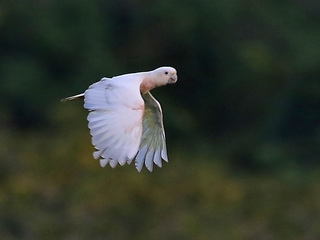
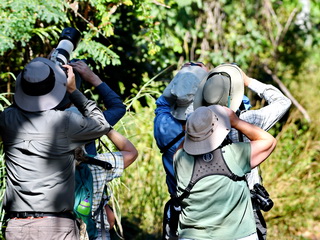
The last morning left us with few target birds, but we were
at Iwahig early and soon adding Square-tailed Drongo-Cucko,
Asian Fairy-bluebird, Blue-eared Kingfisher and Blue
Paradise Flycatcher to the list. We managed good views of
Pin-striped Tit-Babbler and Melodious Babbler, and glimpses
of the difficult Falcated Wren-Babbler. Having enjoyed every
one of the available Palawan endemics it left just one
target bird for our final five minute stop on the way out of
Iwahig, Chestnut-breasted Malkoha, and there it was, part of
one of the best mixed flocks of the tour. Our short time on
Palawan was spent very well as we had managed to see just
about every bird available including the endemics. After
check-out and lunch we headed to the airport for our flight
to Manila and the end of a very successful tour.
Home / Reports / Philippine Tour Page / Our bird list from this tour (pdf)

